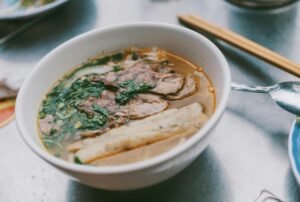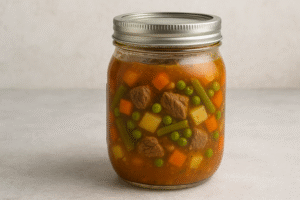Canning Vegetable Beef Soup:
Cunning Vegetable Beef Soup is the perfect way to preserve a hearty, nutritious, and homemade meal for months. If you want to stock your pantry with wholesome, ready-to-eat soups, learning how to can vegetable beef soup properly is essential. This complete guide to canning vegetable beef soup will walk you through its benefits, step-by-step methods, safety precautions, and commonly asked questions, so you can enjoy this comforting classic anytime.
Why Choose Canning for Vegetable Beef Soup?
Canning vegetable beef soup allows you to enjoy a delicious, ready-to-eat meal any time of the year. By preserving soup in jars, you reduce food waste, save money, and have full control over the ingredients. Home-canned soup is free from preservatives and artificial additives commonly found in store-bought options, making it a healthier alternative for you and your family.
Another significant advantage is the convenience. With properly canned vegetable beef soup, you can enjoy a hearty meal within minutes, making it ideal for busy days or emergency situations. Additionally, canning helps you take advantage of seasonal vegetables and fresh beef, locking in their nutrients and flavors.
The Importance of Pressure Canning for Vegetable Beef Soup
Vegetable beef soup contains low-acid ingredients such as meat, carrots, potatoes, and green beans. Due to this, pressure canning is the only safe method for preserving it. Water bath canning is insufficient for low-acid foods as it cannot reach the necessary temperatures to destroy harmful bacteria like Clostridium botulinum.
Pressure canning heats the contents to at least 240°F (116°C), ensuring the elimination of dangerous microorganisms. Following the correct pressure canning procedures minimizes the risk of spoilage and foodborne illnesses.

Selecting the Best Ingredients for Your Soup
Choosing high-quality, fresh ingredients is the first step to making a flavorful vegetable beef soup for canning. Use lean cuts of beef such as stew meat, chuck roast, or sirloin for the best texture and taste. Fresh, firm vegetables like carrots, celery, potatoes, green beans, corn, and tomatoes contribute to both nutrition and flavor.
It is also essential to prepare the ingredients properly. Trim excess fat from the beef to prevent spoilage and peel or wash vegetables thoroughly to remove dirt and pesticides. Uniformly cutting ingredients ensures even cooking and better presentation.
Step-by-Step Guide to Canning Vegetable Beef Soup
Start by preparing all ingredients. Brown the beef in small batches to enhance flavor. Lightly sauté onions, garlic, and other aromatics if desired. Combine beef, vegetables, and broth in a large pot and simmer the mixture until partially cooked. Avoid fully cooking the soup before canning as the process continues during pressure canning.
While the soup simmers, sterilize your canning jars, lids, and bands. Fill the jars with hot soup, leaving one-inch headspace to allow for expansion during processing. Wipe the rims of the jars with a clean, damp cloth to ensure a proper seal.
Place the filled jars in a preheated pressure canner with the recommended amount of water. Lock the lid, and follow the manufacturer’s instructions for venting and building pressure. For most recipes, process quarts of vegetable beef soup at 10 to 11 pounds of pressure for 90 minutes, adjusting for altitude as needed.
Once processing is complete, allow the canner to cool naturally. Carefully remove the jars and let them sit undisturbed for 12 to 24 hours. Check the seals by pressing the center of each lid; properly sealed jars will not flex. Label the jars with the date and store them in a cool, dark place.
Safety Tips for Canning Vegetable Beef Soup
Always follow a tested, reliable recipe when canning vegetable beef soup. Altering ingredient proportions, especially with low-acid foods, can affect the safety of the final product. Do not use thickeners like flour, cornstarch, or cream in canned soup as they interfere with heat penetration.
Inspect jars and lids for cracks or defects before use. Ensure your pressure canner is functioning correctly and that the pressure gauge is accurate. Regular maintenance of your canning equipment reduces the risk of accidents and ensures consistent results.
After canning, discard any jars that have bulging lids, leakage, or signs of spoilage. If in doubt, throw it out to avoid the risk of foodborne illness.
Storage and Shelf Life of Canned Vegetable Beef Soup
Properly canned vegetable beef soup can last up to one year when stored in a cool, dark, and dry environment. Although it may remain safe beyond this period, quality in terms of taste, texture, and nutritional value begins to decline.

Label your jars with the canning date to keep track of freshness. Rotate your stock by using the oldest jars first. Avoid storing canned soup near heat sources or in areas exposed to direct sunlight, as this can compromise the seal and contents.
Enjoying Your Home-Canned Vegetable Beef Soup
Reheating home-canned vegetable beef soup is quick and easy. Simply open a jar, pour the contents into a saucepan, and heat over medium until boiling. You can adjust the seasoning or add cooked pasta or rice for variety.
Canned vegetable beef soup is perfect for quick lunches, camping trips, and emergency meal planning. Having nutritious, ready-to-eat meals on hand offers convenience while maintaining homemade quality.
Frequently Asked Questions About Canning Vegetable Beef Soup
Can I use ground beef in vegetable beef soup?
While some prefer cubed beef for texture, ground beef can be used in vegetable beef soup for canning. Ensure it is browned and drained thoroughly to remove excess fat before adding it to the soup mixture.
Is it safe to add noodles or rice to canned soup?
Adding noodles, rice, or other grains to canned soup is not recommended. These ingredients absorb liquid and affect heat distribution, potentially compromising food safety. Instead, add them when reheating the soup.
How do I know if my canned soup is safe to eat?
Before consuming, inspect the jar for signs of spoilage such as bulging lids, cloudy liquid, off-odors, or mold. If the jar appears compromised or the contents look or smell unusual, discard it immediately.
Can I adjust the seasoning in my canned soup?

You can season your vegetable beef soup before canning, but use dried herbs and spices rather than fresh ones, as fresh herbs can alter the flavor over time. Avoid adding salt substitutes as they may not preserve well. Additional seasoning can always be adjusted after opening.
Is it necessary to peel vegetables before canning?
Peeling vegetables such as carrots and potatoes is recommended to remove dirt, bacteria, and pesticides. This also improves texture and ensures even cooking.
Can I reuse canning lids?
No, canning lids should not be reused. Using new, high-quality lids for each canning session ensures a proper seal and prevents spoilage.
Conclusion
Canning vegetable beef soup is a rewarding process that allows you to preserve delicious, nutritious meals for months. By using high-quality ingredients, following proper pressure canning procedures, and adhering to safety guidelines, you can enjoy homemade soup any time of the year.
Stocking your pantry with home-canned soups reduces waste, saves money, and offers the comfort of knowing exactly what goes into your meals. With careful preparation and storage, your vegetable beef soup will be ready to enjoy when you need it most.